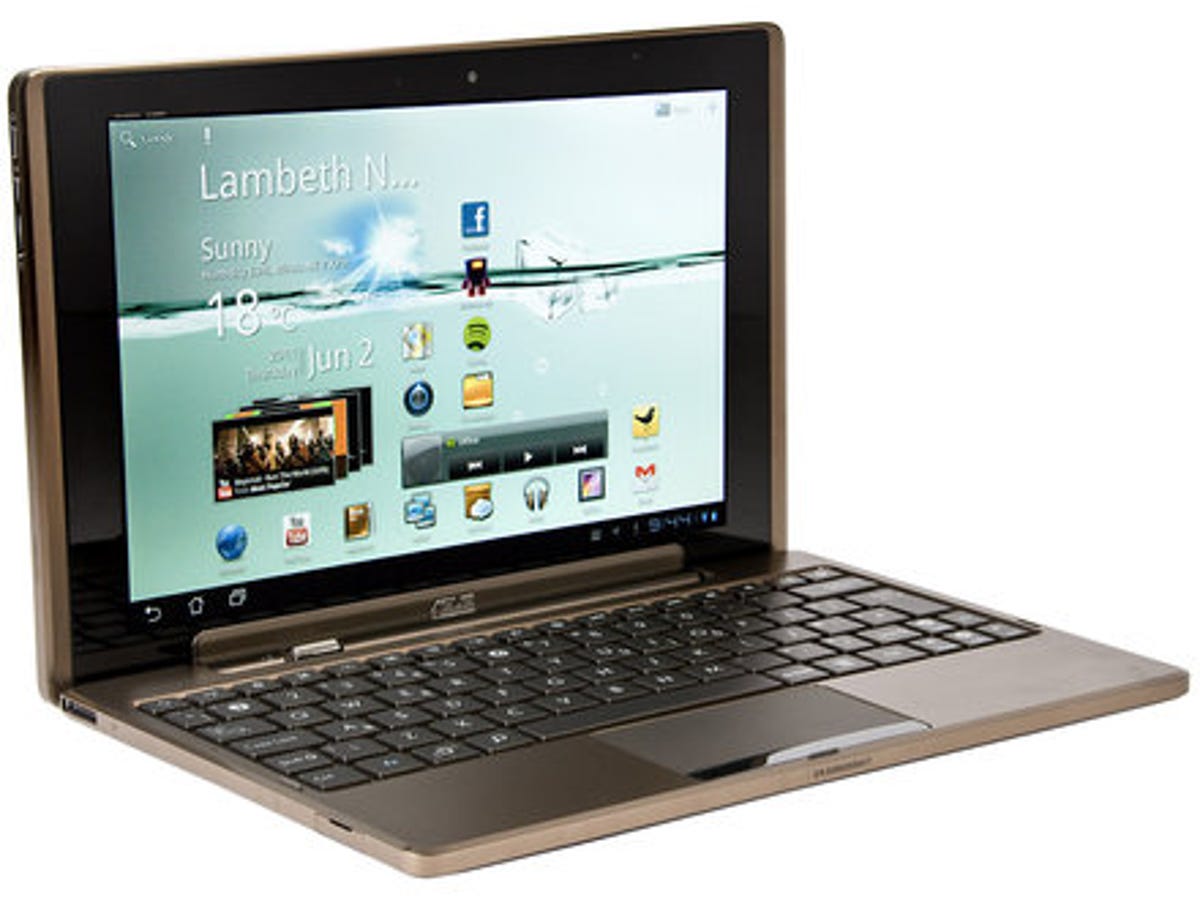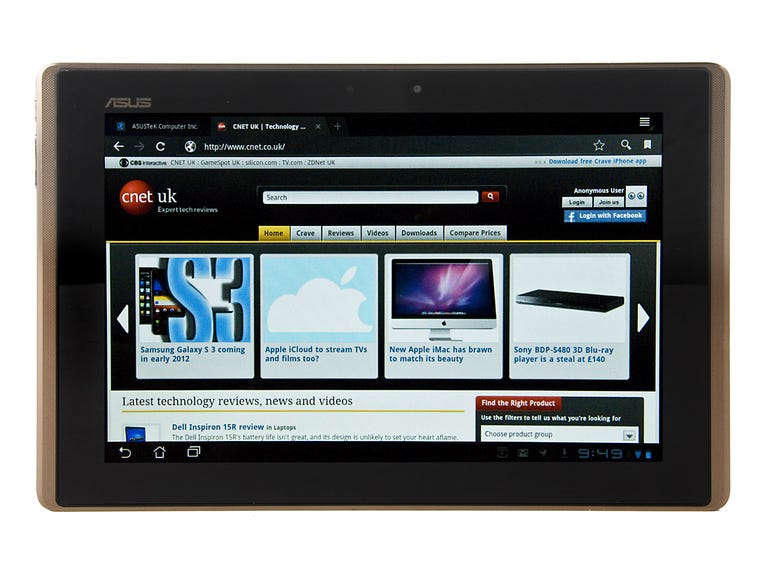 Why You Can Trust CNET
Why You Can Trust CNET Asus Eee Pad Transformer review: Asus Eee Pad Transformer
The 10.1-inch Asus Eee Pad Transformer is a great Android 3.0 Honeycomb tablet, but it's the cleverly designed keyboard dock that makes it really stand out from the crowd. While not perfect, the Transformer's competitive price tag makes it well worth considering.
Honeycomb, the tablet-optimised version of Google's Android operating system, hasn't really found its feet yet -- we weren't overly enamoured with either the bulky Motorola Xoom or the Acer Iconia Tab A500. Asus is trying something more ambitious with the Eee Pad Transformer, though. It's a 10.1-inch tablet with an optional dock that converts it into a laptop.
The Good
The Bad
The Bottom Line
The 16GB version of the tablet costs around £380, while the 32GB version will set you back about £430. Buying the 16GB tablet and dock together will cost you £430. We haven't seen the 32GB tablet on sale together with the dock yet, but you can buy the keyboard separately for around £100. All versions of the Transformer offer Wi-Fi connectivity, but none support 3G.
Phew. Right, let's find out whether Asus can revolutionise the tablet world, just as it revolutionised the world of mini laptops.
Tablet and dock design
The Transformer feels comfortable to hold, thanks to the grippy, textured finish across the back, and around the shorter edges of the tablet. It's more elongated than the squarish iPad 2, and it's heavier than Apple's tablet too, tipping the scales at 680g, while the Wi-Fi-only iPad 2 model weighs 601g.

It's a little weighty then, but we don't think the Transformer is too heavy. It's comfortable to hold, even with one hand, and, if it's been whacked in a rucksack or handbag, you probably won't notice it's there. It's not the slimmest tablet, at 13mm thick, but the back is curved and tapers toward the four edges, so it doesn't feel chunky when you're holding it.
The Transformer's build quality is decent, and its metal construction feels reassuring. That said, we did notice some slight creakiness around the edges of the screen.
Charging is accomplished via a proprietary port on the bottom of the tablet, and this is also where you plug in the keyboard dock.
The dock is made of metal too, and has the same finish on the back as the tablet. Around the edges, there's a multi-format card-reader slot, and two USB ports -- one on the left and one on the right.
The Transformer runs Android 3.0 Honeycomb. The software features five home screens that you can swipe between with a deft flick to the left or right. Within half an hour of powering up the Transformer, we'd filled our primary home screen with downloaded apps; weather, Facebook, Twitter and Spotify widgets; and an attractive live wallpaper, dancing in the background.
That's all great fun, but it's when you plug the Transformer into its dock that the device starts to feel special.
Ease of use
Here's how it works. You whack the Transformer into the dock, and then slide across a locking bar to hold it fast. We struggled occasionally with that catch, and it's not the smoothest or most elegant docking set-up we've ever seen.
When connected, a cursor will pop up on the screen, and any on-screen keyboards will vanish -- you're cruising with physical keys now. Fold the tablet portion down and the Transformer will go into sleep mode. Lift the lid once more, and it wakes up again with no perceptible delay.
Once connected to the dock, the Transformer's essentially an Android netbook. We've seen this kind of device before, one example being the Toshiba AC100. Such netbooks have usually proven frustrating, failing to marry the Android interface well to physical keys.
The Transformer fares much, much better. We were sceptical at first, but cruising around the Web and home screen using the cursor and keyboard felt natural and intuitive, and our reservations gradually melted away.
Any apps that require a healthy amount of text input will benefit from the keyboard, especially email and Polaris Office, a pre-loaded app that lets you create and edit Microsoft Office Word, Excel and PowerPoint files.
When surfing the Web, tabs across the top of the screen keep track of your browsing sessions, and you can scroll down Web pages by dragging down with two fingers on the dock's trackpad -- something that feels smoother and more elegant than on any multi-touch netbook we've used.
The keyboard's been kitted out with buttons specially built for Android. 'Home' and 'search' buttons on the bottom left, and a 'back' button where you'd normally find the 'escape' key are exactly where you'd expect them to be. They all come in very handy.
The combined hardware feels great, outclassing most netbooks we've come across in terms of build quality and usability. We've already mentioned the comfortable, sensitive trackpad, but the keyboard itself deserves a mention too. There's a generous space between each individual key, which cuts down on mistakes while typing, and means you'll be able to build up serious speed while rattling out the next great American novel.
Battery life
One of the best things about the dock is that it houses its own battery pack. Asus reckons you'll get 9.5 hours of battery life from the tablet, and an additional 6.5 hours of juice from the dock, totalling 16 hours. That figure will vary depending on what you're doing with the Transformer -- downloads, gaming and cranking up the screen's brightness will drain the battery faster -- but we were impressed with this tablet's powers away from the mains.
Whenever the dock has juice, it'll selflessly transfer as much power as possible to the Transformer, so the tablet portion is as charged-up as possible for when you want to detach it and go walkies.
We tried plugging in a wireless Bluetooth mouse via the dock's USB ports, and were amazed that the Transformer figured out what was going on, and had the mouse working in seconds. Impressive stuff indeed.
Not everything works perfectly, though. Many sites and apps struggle to understand what's going on when you're using the keyboard and cursor. Particularly gutting is the fact that Google Docs doesn't sit well with the Transformer's keyboard set-up -- you'll have a hard time editing documents or creating new ones.
Performance and connectivity
Break the Transformer away from its keyboard and it'll prove a great tablet in its own right. It comes in 16GB and 32GB versions, with a microSD card slot allowing you to expand the storage space. The tablet also offers HDMI connectivity, and an impressively speedy dual-core Nvidia Tegra 2 chip means the whole system powers along at a fair lick.
Your hi-def movies probably won't play too smoothly. Our 1080p test footage played back very choppily, so you might be better off sticking to lower-res video. Games, on the other hand, run very smoothly.
The 10.1-inch display has a 1,280x800-pixel resolution, which leaves text looking incredibly sharp, and Web pages rendered very clearly. The screen sometimes looks rather dim, though -- something not helped by the blacks and deep blues of Honeycomb's menu system. We had to crank the brightness up to maximum to satisfy our lumen lust.
Around the back, there's a 5-megapixel camera that takes stills and videos of a reasonable quality, but don't expect it to beat a decent compact digital camera. There's a 1.2-megapixel camera on the front of the Transformer too, for video calls.
Honeycomb itself has a few shortcomings. Despite being infinitely customisable and offering a great deal of freedom compared to restrictive platforms like Apple's iOS, it still feels quite geeky, and we still find ourselves occasionally lost in labyrinthine menu systems, and cryptically titled file folders.
There aren't many dedicated Honeycomb apps available yet either. Even if there were, the often baffling Android Market can make it hard to find the apps you're looking for. We love Android, and Honeycomb has stacks of potential, but, if you're seeking a simple, slick, pared-down tablet experience, then you might find more happiness with the iPad 2.
Still, we're very happy with the Transformer's performance as a standalone tablet, and, thanks to an attractive display and slick design, it's definitely one of the best -- if not the best -- Android tablets around.
Better than a netbook?
Is the Transformer a better choice than a netbook? We reckon so, and here's why.
With a Windows netbook, you probably know what you'll be getting, and you'll probably have an easier time when it comes to getting work done. After all, while the Transformer's keyboard dock works very well, Windows has been built for keyboards from the ground up. A comprehensive file system, text-highlighting capability, and keyboard shortcuts, such as copy and paste, are all things you'll miss at some point if you opt for the Transformer.
But, once it's unhinged, the Transformer is a fantastic tablet, with a hi-res display, an intuitive touchscreen interface, access to thousands of apps, and the speed to outstrip most netbooks. More importantly, it's fun to use. The keyboard dock isn't perfect, but it's good, and it's only part of the overall Transformer offering. Flip the catch and you've got yourself one of the best Honeycomb tablets around, at a very competitive price.
Conclusion
The Asus Eee Pad Transformer is a quirky machine, but it really impressed us. Well designed and well constructed, this machine proves that physical keyboards can play well with Android tablets, while still being a great Honeycomb slate in its own right. Carefully considered and well implemented, the keyboard dock adds real value at a competition-beating price.
At the time of writing, there aren't really any Android tablets to rival the Transformer. But you'd be foolish not to consider the gloriously gorgeous, seriously slender and incredibly intuitive iPad 2 before throwing down your cash.
Edited by Charles Kloet


